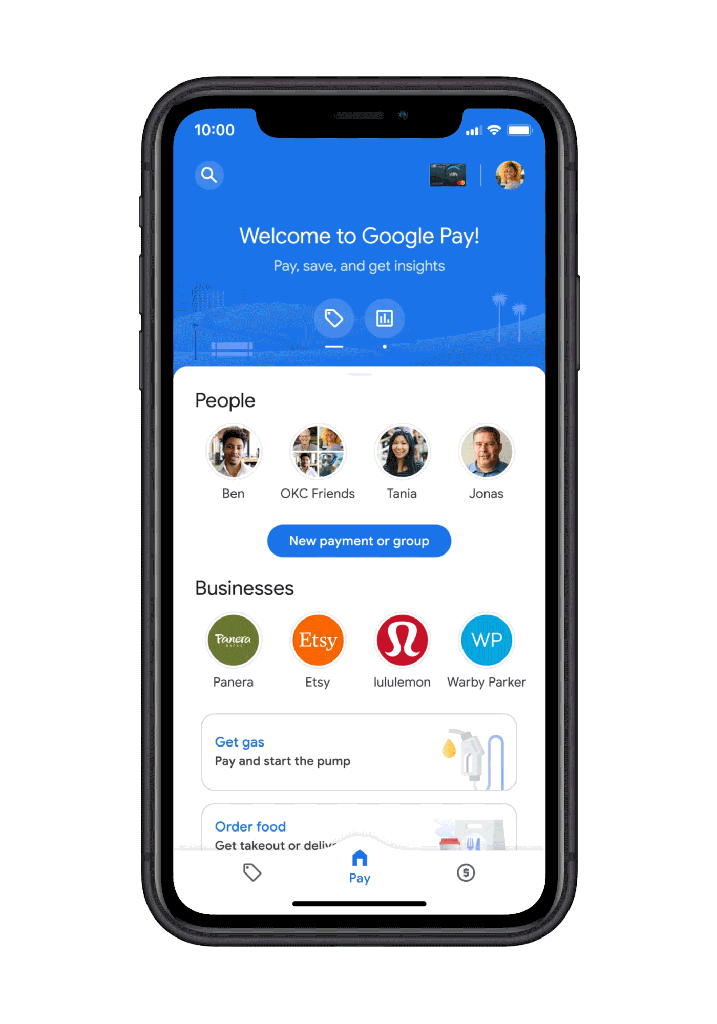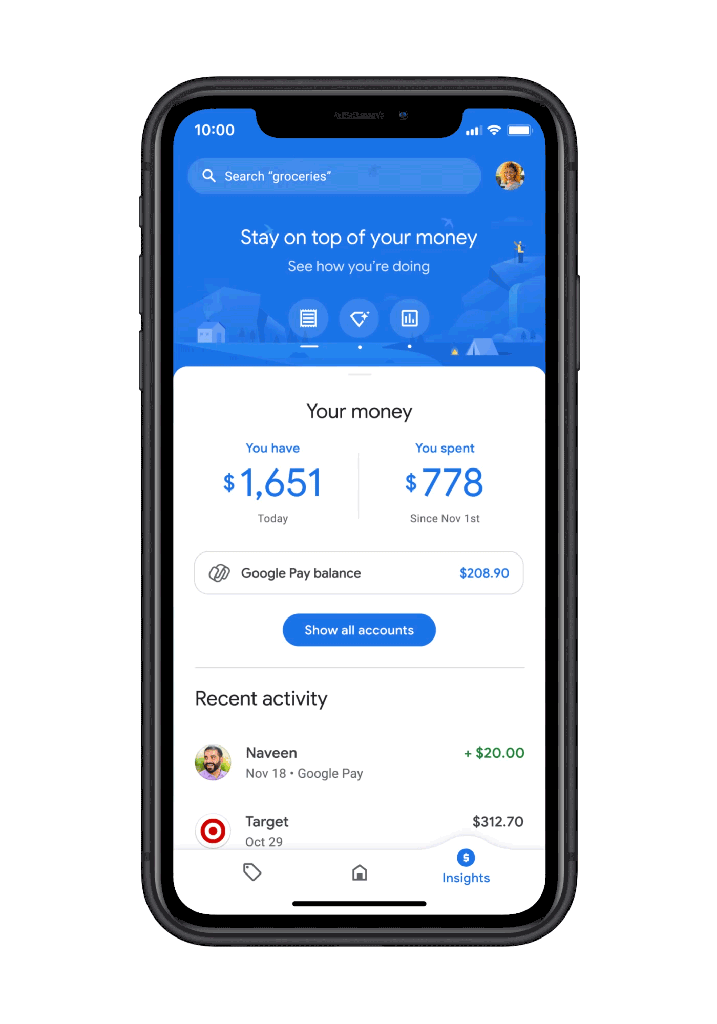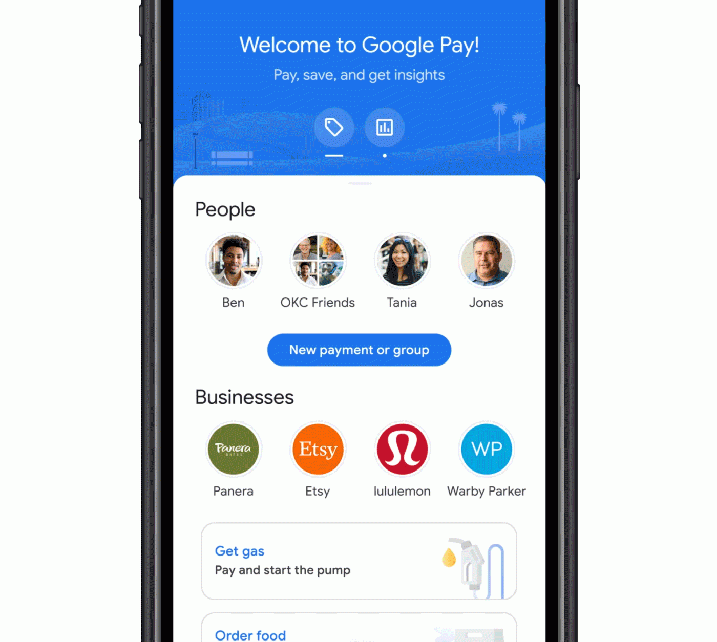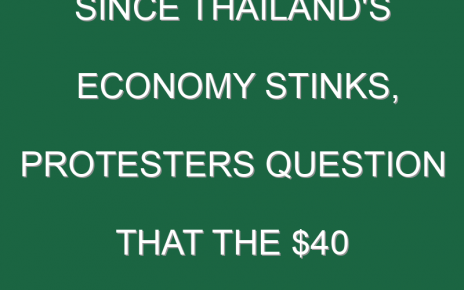Our mission to make business better is fueled by readers like you. To enjoy unlimited access to our journalism, subscribe today.
Google released an overhauled U.S. version of its Google Pay app as a one-stop shop for personal finances and phone-based payments on Wednesday afternoon.
The new app is redesigned around “relationships,” meaning it puts the friends and businesses people transact with most frequently front and center. New features include group payments, or the ability to split expenses among a number of individuals; financial “insights” that show spending summaries to help people manage their money; and merchant-specific pages that collate reward offers, loyalty cards, and transactions into a unified view.
Google also revealed 11 bank partners for a new mobile banking product called Plex, a waitlist for which it made available Wednesday. Banks including Bank Mobile, BBVA, and BMO Harris will join already known collaborators Citi and Stanford Federal Credit Union to offer people fee-less, digital checking and savings accounts starting next year.
“It was time for us to redesign the product, but 2020 also put a certain sense of urgency on it,” says Caesar Sengupta, Google’s head of payments. “Partly because digital payments have obviously increased dramatically. But also because, as you’re looking at one of the worst economic and financial crises we’ve seen in our living history, this is a time when we feel our technology can be of use to people in some small way.”

Google’s other banking partners are Coastal Community Bank, First Independence Bank, Green Dot, Seattle Bank, SEFCU, and the Harbor Bank of Maryland.
When Google debuted Google Pay in January 2018, it primarily made paying with all variety of cards—credit, loyalty, transit—easier. The app joined together Google’s two earlier financial tech, or fintech, or apps: Google Wallet (circa 2011), a peer-to-peer payment service, and Android Pay (circa 2015), which made “contact-less” payments possible from people’s phones.
“The current app, which we designed five years back, was very much built around the use-case of a problem then, which was paying with cards,” Sengupta says. “The world has changed a lot since we launched Android Pay, it’s much more mobile.”
The new Google Pay adds cash back rewards and discounts from popular brands, such as Burger King, REI Co-op, and Target. The app adds integrations to order food at more than 100,000 restaurants, pay for parking in more than 400 cities, including Austin, Boston, and Washington, D.C., and gas-purchasing at more than 30,000 stations, including at Shell, ExxonMobil, Phillips 66, 76, and Conoco.
“More easy ways to pay are coming soon,” Google teased in a blog post.
Josh Woodward, director of product management for Google Pay U.S., demoed some new features for Fortune. He showed off a smarter search function that surfaced recent transactions from a taco joint by searching “Mexican food from last week.” He also pulled up images of receipts containing the word “shirt,” collected from his Gmail and Google Photos accounts.

Google says it will keep people’s financial information private. “We’re never going to sell your data to third parties, and we’re not going to share it with the rest of Google for targeting,” Sengupta explains. “It’s a very clear, plain-speech commitment.” (Of course, note that if you transact with retailers and merchants, join their loyalty programs, and take up rewards, then you’re tacitly agreeing to give them your data.)
The app is so locked down that Google Pay won’t use people’s transaction history to personalize their app experience unless people explicitly grant it permission. People can test run the personalization feature for three months before deciding whether to greenlight it.
Today, Google Pay is available in more than 30 countries and it has more than 150 million monthly users. The redesigned app is now available on both Android and Apple phones. Sengupta adds the features will be rolled out to other regions, including Singapore and India, in the future.
More must-read tech coverage from Fortune:
- Hackers are trying to disrupt and steal COVID-19 vaccine research
- Here’s how President-elect Biden plans to tackle online abuse
- What’s in a name? For Tesla’s Full Self Driving, it may be danger
- What my day on conservative social network Parler was like
- He’s worried A.I. may destroy humanity. Just don’t confuse him with Elon Musk





